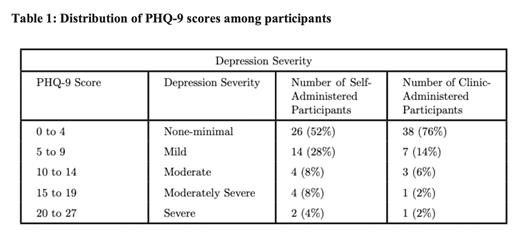Introduction
Sickle Cell Disease (SCD) is an inherited blood disorder affecting approximately 100,000 Americans, most from socially disadvantaged groups. Adults with SCD have a significant burden of depression, which can adversely affect their quality of life, the clinical course of their SCD, and mortality. National guidelines recommend screening for depression in adults annually. Also, adults with SCD may not report symptoms routinely in the clinic since they can be stigmatized. Therefore, screening for depression is critical in managing adults with SCD. A standard tool to screen for depression is the nine-item Patient Health Questionnaire (PHQ-9). This measure can be self-administered on paper or a tablet or administered by healthcare providers or staff in the clinic by asking them questions. There is a gap in our knowledge of the optimal strategy to screen for depression in SCD.
Objective
To close this knowledge gap, we tested the hypothesis that the strategy of a self-administered depression screening questionnaire PHQ-9 on a tablet during clinic would have more positive screenings for depression than the strategy of asking the PHQ-9 questions by nurses.
Methods
This study was part of a prospective cohort of adults with SCD in a patient-centered medical home with an integrated primary care provider at the Ohio State University Wexner Medical Center Comprehensive Sickle Cell Clinic. Adults with any type of SCD were recruited between January 1, 2021, and March 31, 2023. These participants were given tablets to self-administer the PHQ-9 and were also asked the PHQ-9 questions by the nursing staff. The total score determined positive screening and severity of depression. Scores ≥5, ≥10, ≥15, and ≥20 represent mild, moderate, moderately severe, and severe depression, respectively. We used a proportions test for differences among the proportion who screened positive for depression between the two strategies and a Welch's t-test of independence to determine differences in PHQ-9 scores. The Ohio State University IRB approved this study.
Results
A total of 50 adults with SCD, aged 18 to 67, were recruited after meeting the inclusion criteria. Of these 50 adults, 60% were female. The categorization of the severity of depression varied between the two strategies, with more participants in the self-administered group having higher categories of depression (Table 1). Only 24% of the nurse-administered scores screened positive for depression, while 48% of the self-administered scores positively screened for depression (p = 0.02). The mean PHQ-9 score was higher with self-administered PHQ-9 (mean: 5.60; standard deviation (SD): 5.72) compared to clinic-administered PHQ-9 by nurses (mean: 3.32; SD: 4.62, p = 0.03).
Conclusions
Our study is the first to demonstrate the importance of the strategy of screening for depression in adults with SCD. Lower levels of depression were reported when nurses screened for depression compared to when adults with SCD completed the questionnaire independently. The PHQ-9 is commonly used to screen for depression, but depending on the clinic, the administration of the questionnaire may differ, which may lead to suboptimal screening for depression. Identifying the optimal strategy for screening for depression is crucial in this population with a high burden of depression, as depression can ultimately affect their outcomes. This study was limited by being at a single center and the selection bias of only including those who presented in the SCD clinic. Future multi-center studies for optimal strategies to screen, diagnose, and manage depression among adults with SCD are needed.
Disclosures
No relevant conflicts of interest to declare.


This feature is available to Subscribers Only
Sign In or Create an Account Close Modal